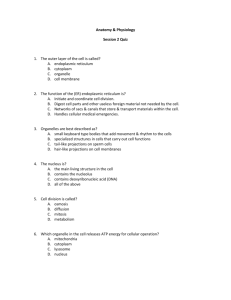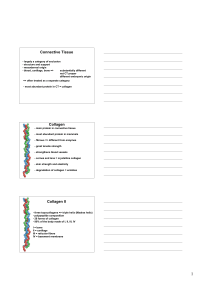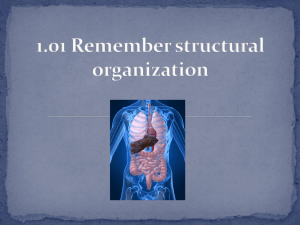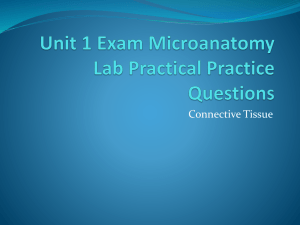1 Connective Tissue Dr Amam
advertisement
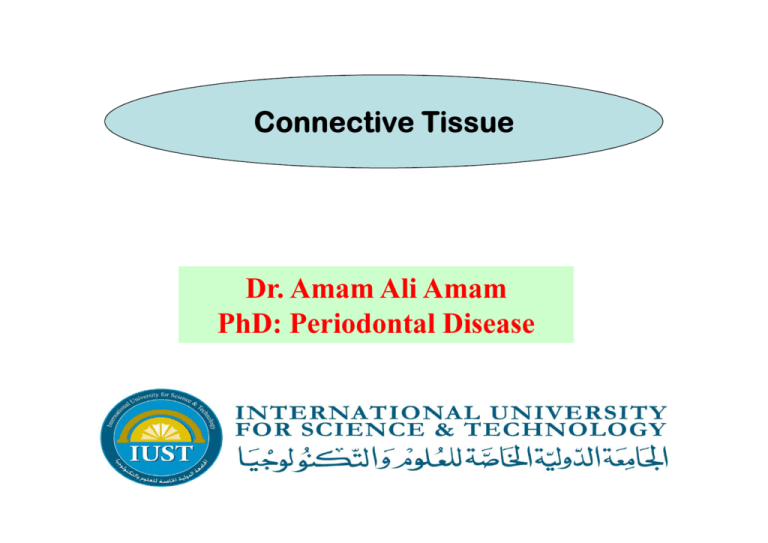
Connective Tissue Dr. Amam Ali Amam PhD: Periodontal Disease How are we going to study connective tissue? • Study connective tissue components • Focus on different cell types characters and properties • Where and when to find these cells. What’ r we going to study in these cells 1. Properties, characterization and shape 2. Function. 3. Origin (from where they are derived?) The human body is composed of only 4 basic types of tissue Epithelial tissue Connective tissue Muscular tissue Nervous tissue They are formed by: Cells Molecules of the extracellular matrix The main characteristics of these basic types of tissue: Tissue Cells Extracellular matrix Main Function Nervous Intertwining elongated None processes Transmission of nervous impulses Epithelial Aggregated polyhedral Very small amount Lining of surface cells or body cavities, glandular secretion Muscle Elongated contractile cells Moderate amount Movement Connective Several types of fixed and wandering cells Abundant amount Support and protection Epithelial, Muscle & Nerve Tissues are formed mainly by: Cells Connective Tissue The major constituent is: Extracellular matrix Connective Tissue Characterized by: The abundance of extracellular material produced by its cells. Present in all systems Specialized connective tissue: 1- Adipose tissue. 2- Cartilage. 3- Bone. Originate from the mesenchyme. The mesenchyme develops from middle layer of the embryo Connective Tissues Definition: They are responsible for providing and maintaining form in the body. Function: They are providing the matrix that: 1- connects . 2- binds the cells & organs, 3- gives support to the body. Connective Tissues Components & Function • Fibroblasts: Fibroblasts and Fibrocyte, Other cells • Fibers: structure & the most resistant componant of stroma. In some organs they form walls & the trabecular . • Ground substance: macromolecules & multiadhesive glycoproteins. – They are the storage of controls of the cells. – Medium for nutrition and wastes. Structure of Connective Tissue 3 classes of components 1- Cells 1-Fibroblast. 2-Macrophage. 3-Mast cell. 4-Plasma cell. 5-Lymphocytes. 6-Leukocytes. 7-Adipose cell. 2- Fibers Reticular Elastic Collagen Extracellular matrix 3- Ground substance macromolecules multiadhesive glycoproteins Extracellular matrices Consist of different combinations of: 1- Protein Fibers Collagen Reticular Elastic Elastin = Amine Acid + Cholesterol 2- Ground substance macromolecules multiadhesive glycoproteins Cells seen in connective tissue 1-Fibroblast. 2-Macrophage. 3-Mast cell. 4-Plasma cell. 5-Lymphocytes. 6-Leukocytes. 7-Adipose cell. Fibers composed of: Collagen Constitute Tendons Aponeuroses Capsules of organs Membranes That envelop CNS (meninges) Fibroblast properties: Synthesize collagen, elastin, glycosaminoglycans, protyoglycans, and multiadhesiveprotiens. The most common cells in the connective tissue and most important. They can go from resting to activating phase depending on: Stimulation such as: body injury (inflammation, trauma). Involved in the production of growth factors, etc. Fibroblast The comparison between Fibroblasts (active) & Fibrocytes (rest) The quiescent Fibroblasts (Fibrocyte) Smaller than the active Fibroblasts. Spindle shape. Fewer processes. Darker. Elongated nucleus. Acidophilic cytoplasm. Small amount of rough endoplasmic reticulum. Fibroblasts & Fibrocytes Active Quiescent Function of connective tissue cells Cell Type Representative Product or Activity Representative Function Fibroblast, chondroblast, Osteoblast. Production of fibers & ground substance Structural Plasma cell Production of antibodies. Immunological (defense) Lymphocyte (several types) Production of immunocompetent cells Immunological (defense) Eosinophilic leukocyte Participation in allergic & vasoactive reactions, modulation of mast cell activities and the inflammatory process. Immunological (defense) Neutrophilic leukocyte Phagocytosis of foreign substances, bacteria Defense. Macrophage Secretion of cytokines and other molecules, phagocytosis of foreign substances and bacteria, antigen processing and presentation to other cells. Defense. Mast cell & basophilic leukocyte Liberation of pharmacologically active molecules (eg, histamine) Defense Adipose (fat) cell Storage of neutral fats. Energy reservoir, heat production. (participate in allergic reactions Connective tissue cells Connective tissue cells Function of connective tissue cells Cell Type Location Main Function Monocyte Blood Precursor of macrophages Macrophage Connective tissue, Lymphoid organs, Lungs, Bone marrow Production of cytokines, chemotactic factors, and several other molecules that participate in inflammation (defense), antigen processing and presentation. Kupffer cell Liver Same as macrophages. Microglia cell Nerve tissue of the CNS Same as macrophages. Langerhans cell Skin Antigen processing and presentation. Dendritic cell Lymph nodes Antigen processing and presentation. Osteoclast. Bone (fusion of several macrophages) Digestion of bone. Multinuclear giant cell Connective tissue (fusion of several macrophages). Segregation and digestion of foreign bodies, Macrophage Characterization Property& shape Surface: irregular. The cytoplasma: granular Nucleus: oval eccentric nucleus or kidney. Age: long life. Function A phagocytic ability & Secrete cytokines Origin (derived) Defense. Bone marrow, then from monocytes then immigrates to connective tissue Special names of Macrophage Kupffer cell in the Liver. Microglial cells in the CNS. Langerhans cells of the Skin. Osteoclasts in Bone tissue. Monocytes & Macrophage are the same cell in different stages of maturation. Distributed throughout the body & constitute the mononuclear phagocyte system Macrophage Macrophage Mast cell Cells: Round to oval. Characterization The cytoplasma: filled with basophilic granules. Property& shape Nucleus: spherical centric. storage of mediators of the inflammatory response. & Function liberation of pharmacologically active molecules. Defense as allergic reaction. Bone marrow (from progenitor cells), Origin (derived) then immigrates to connective tissue. Mast cell Mast cell The surface of mast cells contains specific receptors for immunoglobulin E ( IgE). IgE is a type of immunoglobulin produced by Plasma cells. Mast cell Plasma cell Characterization Property& shape Function Origin (derived) Cells: large & ovoid . The cytoplasm: basophilic. Nucleus: spherical eccentric, with dense compact chromatin. Age: short life (10-20 days). Synthesis of antibodies. Defense (immunological). B lymphocyte. Plasma cell Plasma cell Lymphocytes, Leukocytes ( white blood corpuscles) Characterization Property& shape to be discussed later ( lymphoid organs). Defense: when there is Function inflammation they immigrates to connective tissue Origin (derived) Bone marrow (they migrate from the blood vessels by diapedesis). Collagen fibers Basesd on their structure & functions they can classified into 4 groups 1-Collagen that form long fibrils 2- Fibril- associated Collagen. 3-Collagen that form a network 4-Collagen that form anchoring fibrils Collagen fibers Elastin fibres Elastin fibres Reticular fibres Ground substance 3 classes of components Glycosaminoglycans Called acid mucopolysaccharides Proteoglycans a core protein with 4 main Glycosaminoglycans 1- dermatan sulfate. 2- chondroitin sulfate. 3- keratan sulfate. 4- heparan sulfate. multiadhesive glycoproteins Adipose tissue Characterization, Property& shape Adipose tissue is a special connective tissue in which adipose cells predominate. Often called Fat cells. Adipose cells (Adipocytes) predominate. Isolated in small groups within connective tissue or found in large aggregates. It’s one of the largest tissue in the body. In men 15-20 % of the body weight. In women 20-25 % of the body weight. It’s a very efficient storage tissue. Fills up spaces between other tissues, keep some organs in place. Both types of adipose tissue have a rich blood supply. It spreads all over the body. Adipose tissue Functions It is the largest storage of energy of the body (triglycerides), the other organs are liver & skeletal muscle (glycogen). Energy reservoir, heat production. Types of Connective Tissue Section of Loose Connective Tissue Proper Section of Loose Connective Tissue Proper Section of immature dense irregular Connective Tissue Proper Longitudinal section of dense regular Connective Tissue Dense supporting tissue Mucous Tissue of an embryo Adipose tissue Adipose tissue 1- Unilocular adipose 2- Multilocular adipose Tissue tissue brown Common or yellow 1- Unilocular adipose tissue Common or yellow Color: white to dark yellow. Characterization Distribution : all the body except the eyelids, the Property& shape scrotum, etc. Uniform: In newborn has a uniform thickness throughout the body. Cells: spherical (if isolated), polyhedral (in adipose tissue, closely packed). The cytoplasm: thin ring (single ring cell), contains a Golgi complex, mitochondria, free polyribosomes. Nucleus: eccentric & flattened. Surrounded by a basal lamina. Function Origin (derived) In Starving and Obesity: release or storing fat , that’s mean, cell size differs not cells numbers! Lipoblast from ( Mesenchymal cell). Unilocular adipose tissue Unilocular & Multilocular adipose tissue, Origin (derived) 2- Multilocular adipose tissue Brown fat Cell: Polygonal and smaller cells (than Unilocular) . Nucleus: spherical & central. Color & Called : Brown fat (large number of blood capillaries & numerous mitochondria (colored Characterization cytochromes). Property& shape The cytoplasm: great number of lipid droplets (various sizes). Distribution: Limited ( animals; hibernating gland). Function Origin (derived) Produce heat. In newborn and hibernating animals: to raise the body heat as this tissue is a wellinnervated tissue. Lipoblast from ( Mesenchymal cell). mesenchemical cells that resemble epithelial cells. Distribution of adipose tissue Multliocular adipose tissue in a human newborn Multiocular adipose Tissue Brown adipose tissue


